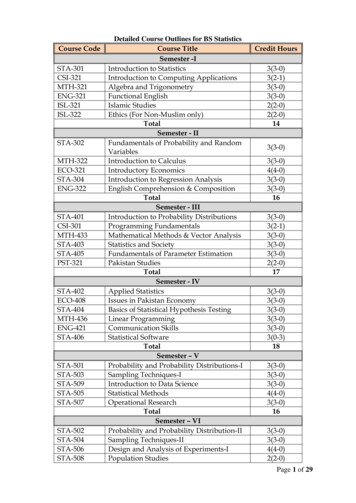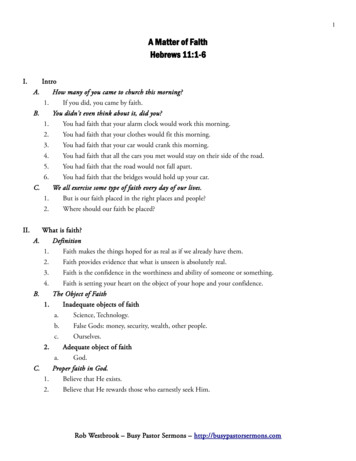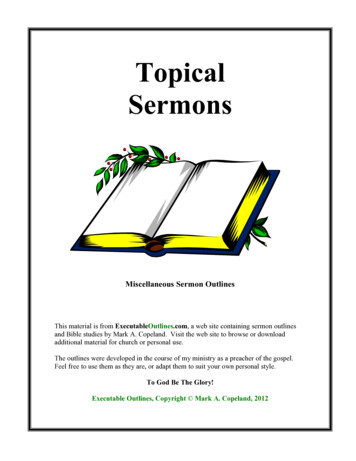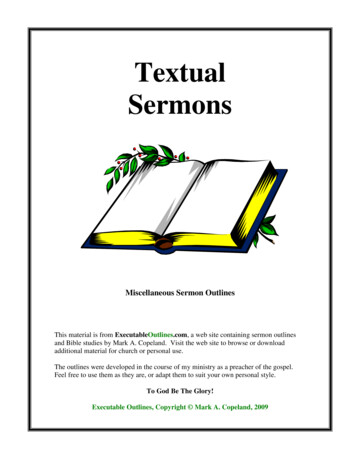
Transcription
Course STA-502STA-504STA-506STA-508Detailed Course Outlines for BS StatisticsCourse TitleSemester -IIntroduction to StatisticsIntroduction to Computing ApplicationsAlgebra and TrigonometryFunctional EnglishIslamic StudiesEthics (For Non-Muslim only)TotalSemester - IIFundamentals of Probability and RandomVariablesIntroduction to CalculusIntroductory EconomicsIntroduction to Regression AnalysisEnglish Comprehension & CompositionTotalSemester - IIIIntroduction to Probability DistributionsProgramming FundamentalsMathematical Methods & Vector AnalysisStatistics and SocietyFundamentals of Parameter EstimationPakistan StudiesTotalSemester - IVApplied StatisticsIssues in Pakistan EconomyBasics of Statistical Hypothesis TestingLinear ProgrammingCommunication SkillsStatistical SoftwareTotalSemester – VProbability and Probability Distributions-ISampling Techniques-IIntroduction to Data ScienceStatistical MethodsOperational ResearchTotalSemester – VIProbability and Probability Distribution-IISampling Techniques-IIDesign and Analysis of Experiments-IPopulation StudiesCredit )2(2-0)Page 1 of 29
STA-510Statistical Quality ControlSTA-512Survey Research MethodsTotalSemester – VIIEconometrics-IDesign and Analysis of Experiments-IIMultivariate Analysis-IStatistical Inference-IStatistical Computing 1(0-1)18Semester – VIIISTA-602Econometrics-IISTA-604Statistical Computing -IISTA-606Multivariate Analysis-IISTA-608Statistical Inference-IIAny One of The Following A-620Analysis of Time Series and ForecastingCategorical Data AnalysisSurvival Data AnalysisNon Parametric MethodsBayesian StatisticsResearch ReportTotalTotal Credit Hours to be offered in BS Statistics4(0-4)17133Page 2 of 29
Changed/added courses for SEMESTER-ISTA-301Introduction to Statistics3(3-0)Meanings of Statistics, Main branches of Statistics, Types of variables, Measurements scales,Errors of measurment, Significant digits, Statistical data collection, Organizing of data,Classification of data, Graph and charts: Stem and Leaf diagram, Box and Whisker plots.Graph based on frequency distribution: Histogram, Frequency polygon, Ogive, Pie-chart.Measure of central tendency: Arithmetic mean, Median, Mode, Geometric mean, Harmonicmean, Weighted arithmetic mean, Their properties, Merits and demerits, Quantilies, The boxplots, Empirical relation between mean, median and mode.Measure of Dispersion: Absolute and relative measure of dispersion, Their properties, Meritsand demerits, Standardized variables, Moments, Sheppard’s correction, Moments ratios,Coefficient of kurtosis and skewness, Trimmed and Winsorized mean.Books Recommended:1. Spiegel, M.R. Schiller, J.L. and Sirinivasan, R.L. (2001) “Probability and Statistics”,4th ed. Schaums Outlines Series. McGraw Hill. New York.2. Wonnacott, T.H. and Wannacott, R.J (1999). “Introductory Statistics”, 5th ed. JhonWily & Sons. New York.3. Walpole, R.E (2020). “Introduction to Statistics”, 3rd ed. Macmillan PublishingCompany. New York.4. Rauf, M (2001). “Polymer’s Modern Statistics”, Polymer Publication, Urdu Bazar,Lahore.5. Chaudhary, SM and Kamal, S. (2011) “Introduction to Statistical Theory” Parts I &II, 6th ed, Ilmi Kitab Khana, Lahore, Pakistan.Reference Books1. Clark, G.M and Cooke, D. (2002), “A Basic Course in Statistics”, 4th ed, Arnold,London.2. Walpole, R.E., Myers, R.h and Myers, S.L. (2012), “Probability and Statistics forEngineers and Scientists”, 9th Edition, Prentice Hall, New York.3. Mclave, J.T., Benson, P.G. and Snitch, T. (2019) “Statistics for Business &Economics”, 14th ed. Prentice Hall, New Jerssey4. Weiss, N.A. (2015), “Introductory Statistics” 10th ed. Addison-Wesley Publication.Company. Boston.CSI-321Introduction to Computing Applications3(2-1)As per outlines prepared by Department of Computer ScienceMTH-321Algebra and Trigonometry3(3-0)As per outlines prepared by Department of MathematicsENG-321Functional English3(3-0)Page 3 of 29
As per outlines prepared by Department of EnglishISL-321ISL-322Islamic StudiesEthics (For No-Muslim only)2(2-0)2(2-0)As per outlines prepared by Department of Islamic e 4 of 29
SEMESTER-IISTA-302Fundamentals of Probability and RandomVariables3(3-0)Sets theory, Counting rules: multiplication rule, combination, permutation, Randomexperiment, Types of events, Definitions of probability, Laws of probability: complement,addition, multiplication, independence, conditional probability, Total probability andBayes’rule.Random variable, Distribution function, Discrete random variables and its probabilydistribution, Continous random variables and its probabily density function, Jointdistributions: bivariate distribution functions, bivariate probability functions, marginalprobability functions, conditional probability functions, independence, continous bivariatedistributions. Mathematical expectations of a random variables, Median and mode ofcontionous random variables, Chebyshev’s inequality, Moment generating functions,Cumulant generating functions, relation between cumulants and moments, Characteristicfunction.Books Recommended:1. Spiegel, M.R. Schiller, J.L. and Sirinivasan, R.L. (2001) “Probability and Statistics”,4th ed. Schaums Outlines Series. McGraw Hill. New York.2. Wonnacott, T.H. and Wannacott, R.J (1999). “Introductory Statistics”, 5th ed. JhonWily & Sons. New York.3. Walpole, R.E (2020). “Introduction to Statistics”, 3rd ed. Macmillan PublishingCompany. New York.4. Rauf, M (2001). “Polymer’s Modern Statistics”, Polymer Publication, Urdu Bazar,Lahore.5. Chaudhary, SM and Kamal, S. (2011) “Introduction to Statistical Theory” Parts I &II, 6th ed, Ilmi Kitab Khana, Lahore, Pakistan.Reference Books1. Clark, G.M and Cooke, D. (2002), “A Basic Course in Statistics”, 4th ed, Arnold,London.2. Walpole, R.E., Myers, R.h and Myers, S.L. (2012), “Probability and Statistics forEngineers and Scientists”, 9th Edition, Prentice Hall, New York.3. Mclave, J.T., Benson, P.G. and Snitch, T. (2019) “Statistics for Business &Economics”, 14th ed. Prentice Hall, New Jerssey4. Weiss, N.A. (2015), “Introductory Statistics” 10th ed. Addison-Wesley Publication.Company. Boston.STA-304Introduction to Regression Analysis3(3-0)Concept of regression analysis, scatter diagram, Simple linear regression, its model andassumptions, Mutiple linear regression, Fitting of non-linear regression, Standard error ofestimate, Coefficient of determination and its interpretation, Correlation and causation.Correlation coefficient, its properties and interpretation, Multiple and partial correlationcoefficient and its interpretation.Books Recommended:Page 5 of 29
1. Spiegel, M.R. Schiller, J.L. and Sirinivasan, R.L. (2001) “Probability and Statistics”,4th ed. Schaums Outlines Series. McGraw Hill. New York.2. Wonnacott, T.H. and Wannacott, R.J (1999). “Introductory Statistics”, 5th ed. JhonWily & Sons. New York.3. Walpole, R.E (2020). “Introduction to Statistics”, 3rd ed. Macmillan PublishingCompany. New York.4. Rauf, M (2001). “Polymer’s Modern Statistics”, Polymer Publication, Urdu Bazar,Lahore.5. Chaudhary, SM and Kamal, S. (2011) “Introduction to Statistical Theory” Parts I &II, 6th ed, Ilmi Kitab Khana, Lahore, Pakistan.Reference Books1. Clark, G.M and Cooke, D. (2002), “A Basic Course in Statistics”, 4th ed, Arnold,London.2. Walpole, R.E., Myers, R.h and Myers, S.L. (2012), “Probability and Statistics forEngineers and Scientists”, 9th Edition, Prentice Hall, New York.3. Mclave, J.T., Benson, P.G. and Snitch, T. (2019) “Statistics for Business &Economics”, 14th ed. Prentice Hall, New Jerssey4. Weiss, N.A. (2015), “Introductory Statistics” 10th ed. Addison-Wesley Publication.Company. Boston.MTH-322Introduction to Calculus3(3-0)As per outlines prepared by Department of MathematicsECO-321Introductory Economics4(4-0)As per outlines prepared by Department of EconomicsENG-322English Comprehension And Composition3(3-0)As per outlines prepared by Department of e 6 of 29
SEMESTER-IIISTA-401Introduction to Probability Distributions3(3-0)Basic properties (mean, variance, moment generating function) and applications of followingunivariate discrete probability distributions: Uniform Distribution, Bernoulli Distribution,Binomial Distribution, Poisson Distribution, Hypergeometric Distribution, Geometricdistribution, Negative Binomial distribution.Properties (total area under the normal curve, mean, median, mode, variance, mean deviation,quartile deviation, odd and even order moments, moment generating function, cumulantgenerating function, coefficient of skewness and coefficient of kurtosis) and application ofthe Normal distribution.Books Recommended:1. Spiegel, M.R. Schiller, J.L. and Sirinivasan, R.L. (2001) “Probability and Statistics”,4th ed. Schaums Outlines Series. McGraw Hill. New York.2. Wonnacott, T.H. and Wannacott, R.J (1999). “Introductory Statistics”, 5th ed. JhonWily & Sons. New York.3. Walpole, R.E (2020). “Introduction to Statistics”, 3rd ed. Macmillan PublishingCompany. New York.4. Rauf, M (2001). “Polymer’s Modern Statistics”, Polymer Publication, Urdu Bazar,Lahore.5. Chaudhary, SM and Kamal, S. (2011) “Introduction to Statistical Theory” Parts I &II, 6th ed, Ilmi Kitab Khana, Lahore, Pakistan.Reference Books1. Clark, G.M and Cooke, D. (2002), “A Basic Course in Statistics”, 4th ed, Arnold,London.2. Walpole, R.E., Myers, R.h and Myers, S.L. (2012), “Probability and Statistics forEngineers and Scientists”, 9th Edition, Prentice Hall, New York.3. Mclave, J.T., Benson, P.G. and Snitch, T. (2019) “Statistics for Business &Economics”, 14th ed. Prentice Hall, New Jerssey4. Weiss, N.A. (2015), “Introductory Statistics” 10th ed. Addison-Wesley Publication.Company. Boston.STA-403Statistics and Society3(3-0)Statistical ideas and their relevance to public policy, business, humanities, and the social,health, and physical sciences; focus on critical approach to statistical evidence, quantitative orformal reasoning. How numbers are deployed in social settings, and how they are used insociology to construct and challenge our understanding of the social world. Introducesstudents of quantification in modern societies, familiarization with the main instruments forthe collection of quantitative data, and providing an overview of the methods used to treatsuch data in contemporary sociology. Descriptive and explanatory methods, and the vision ofthe social world implicitly associated with each of the methods we encounter. Basicdescriptive skills of quantitative data analysis, notably how to download large data sets, howto manipulate variables and how to present statistical information in tabular and graphicalform. Uses and misuses of Statistics in society.Page 7 of 29
References: Wasserman, L. (2004). All of Statistics, A Concise Course in Statistical Inference,Springer Texts in Statistics.Chava, F. N. , Anna L. G. (2018). Social Statistics for a Diverse Society 8th Edition,SAGE Publications Inc.Dani, B. Z., Katie, M., Joan, G. (2017) International Handbook of Research inStatistics Education, SpringerSTA-405Fundamentals of Parameter Estimation3(3-0)Basic definition, Objective, advantages and disadvantages of sampling, Types of probabilityand non-probability sampling, Sampling distribution of mean under simple random samplingwith and without replacements, Difference between two mean under simple random samplingwith and without replacements, Variances, Proportion, Difference between two proportions,Central limit theorem.Point estimation and its properties (unbiasedness, consistency, efficiency, sufficiency), Pointestimate for population mean, Difference between two population means, proportion anddifference between two population proportion, Population variance, Interval estimation,Confidence interval and its interpretation, Confidence interval for population mean,Difference between two population means, Proportion and difference between two populationproportions, Population variance, One sided confidence interval, Determination of samplesize for estimating population mean and proportion.Books Recommended:1. Spiegel, M.R. Schiller, J.L. and Sirinivasan, R.L. (2001) “Probability and Statistics”,4th ed. Schaums Outlines Series. McGraw Hill. New York.2. Wonnacott, T.H. and Wannacott, R.J (1999). “Introductory Statistics”, 5th ed. JhonWily & Sons. New York.3. Walpole, R.E (2020). “Introduction to Statistics”, 3rd ed. Macmillan PublishingCompany. New York.4. Rauf, M (2001). “Polymer’s Modern Statistics”, Polymer Publication, Urdu Bazar,Lahore.5. Chaudhary, SM and Kamal, S. (2011) “Introduction to Statistical Theory” Parts I &II, 6th ed, Ilmi Kitab Khana, Lahore, Pakistan.Reference Books1. Clark, G.M and Cooke, D. (2002), “A Basic Course in Statistics”, 4th ed, Arnold,London.2. Walpole, R.E., Myers, R.h and Myers, S.L. (2012), “Probability and Statistics forEngineers and Scientists”, 9th Edition, Prentice Hall, New York.3. Mclave, J.T., Benson, P.G. and Snitch, T. (2019) “Statistics for Business &Economics”, 14th ed. Prentice Hall, New Jerssey4. Weiss, N.A. (2015), “Introductory Statistics” 10th ed. Addison-Wesley Publication.Company. Boston.Page 8 of 29
CSI-301Programming Fundamentals3(2-1)As per outlines prepared by Department of Computer ScienceMTH-433Mathematical Methods & Vector Analysis3(3-0)As per outlines prepared by Department of MathematicsPST-321Pakistan Studies2(2-0)As per outlines prepared by Department of Pakistan e 9 of 29
SEMESTER-IVSTA-402Applied Statistics3(3-0)Index Number: Construction and application of index number. Simple and composite Indexnumber. Fixed based and chain base method. Unweighted and weighted index number.Theoretical tests for index number.(Time Reversal Tests, Factor Reversal Test, CircularTest). Consumer price Index Number and Sensitive Price Index Number. Determination ofPurchasing Power of Money, Real Wages, Inflation Rate on the basis of index number.Limitation of Index Number.Time Series Analysis: Time Series Data, Components of Time Series, Measurements ofSystematic components of time series ( Measurement of Secular Trend, Seasonal Variation,Cyclical Fluctuation). Detrending, Deseasonalization of data, Forecasting and Prediction.Vital Statistics: Meaning of Vital Statistics, registration of births and deaths in Pakistan.Uses of Vital statistics, Short comings of vital statistics, rates and ratio (Sex ratio, child ratio,birth and death ratio, population growth rate, classification of natal rates, death rates ormortality rates, crude death rate, infant mortality rate, specific death rate, case fatality rate,fertility rate, crude birth rate, specific birth rate, standardized death rate, reproduction rate,gross reproduction rate. Net reproduction rate, morbidity or sickness rate, marriage rate,divorce rate, etc. general fertility rate, total fertility rate.)Books Recommended:1. Spiegel, M.R. Schiller, J.L. and Sirinivasan, R.L. (2001) “Probability and Statistics”,4th ed. Schaums Outlines Series. McGraw Hill. New York.2. Wonnacott, T.H. and Wannacott, R.J (1999). “Introductory Statistics”, 5th ed. JhonWily & Sons. New York.3. Walpole, R.E (2020). “Introduction to Statistics”, 3rd ed. Macmillan PublishingCompany. New York.4. Rauf, M (2001). “Polymer’s Modern Statistics”, Polymer Publication, Urdu Bazar,Lahore.5. Chaudhary, SM and Kamal, S. (2011) “Introduction to Statistical Theory” Parts I &II, 6th ed, Ilmi Kitab Khana, Lahore, Pakistan.Reference Books1. Clark, G.M and Cooke, D. (2002), “A Basic Course in Statistics”, 4th ed, Arnold,London.2. Walpole, R.E., Myers, R.h and Myers, S.L. (2012), “Probability and Statistics forEngineers and Scientists”, 9th Edition, Prentice Hall, New York.3. Mclave, J.T., Benson, P.G. and Snitch, T. (2019) “Statistics for Business &Economics”, 14th ed. Prentice Hall, New Jerssey4. Weiss, N.A. (2015), “Introductory Statistics” 10th ed. Addison-Wesley Publication.Company. Boston.Page 10 of 29
STA-404Basics of Statistical Hypothesis Testing3(3-0)Basic definitions in hypothesis testing, types of error, power of test, construction andinterpretation of OC curve. Hypothesis testing for single Normal population mean, proportionvariance and regression parameters. Hypothesis testing for difference between two normalpopulations’ means, proportions and ratio of two populations’ variances.Testing the hypothesis for equality of several normal population variances (test forhomogeneity). Chi-Square independence test, Goodness of fit test.Analysis of variance, One way analysis of variance, Two way analysis of variance,Partitioning of total SS and degree of freedom in one way and two way analysis of variance,Multiple comparisons tests.Books Recommended:1. Spiegel, M.R. Schiller, J.L. and Sirinivasan, R.L. (2001) “Probability and Statistics”,4th ed. Schaums Outlines Series. McGraw Hill. New York.2. Wonnacott, T.H. and Wannacott, R.J (1999). “Introductory Statistics”, 5th ed. JhonWily & Sons. New York.3. Walpole, R.E (2020). “Introduction to Statistics”, 3rd ed. Macmillan PublishingCompany. New York.4. Rauf, M (2001). “Polymer’s Modern Statistics”, Polymer Publication, Urdu Bazar,Lahore.5. Chaudhary, SM and Kamal, S. (2011) “Introduction to Statistical Theory” Parts I &II, 6th ed, Ilmi Kitab Khana, Lahore, Pakistan.Reference Books1. Clark, G.M and Cooke, D. (2002), “A Basic Course in Statistics”, 4th ed, Arnold,London.2. Walpole, R.E., Myers, R.h and Myers, S.L. (2012), “Probability and Statistics forEngineers and Scientists”, 9th Edition, Prentice Hall, New York.3. Mclave, J.T., Benson, P.G. and Snitch, T. (2019) “Statistics for Business &Economics”, 14th ed. Prentice Hall, New Jerssey4. Weiss, N.A. (2015), “Introductory Statistics” 10th ed. Addison-Wesley Publication.Company. Boston.STA-406Statistical Software3(0-3)Statistical Data analysis using MS Excel, MinitabMTH-436Linear Programming3(3-0)As per outlines prepared by Department of MathematicsECO-408Issues in Pakistan Economy3(3-0)As per outlines prepared by Department of EconomicsENG-421Communication Skills3(3-0)As per outlines prepared by Department of EnglishPage 11 of 29
SEMESTER-VSTA-501Probability and Probability Distributions-I3(3-0)Probability set function. Kolomogrov’s axioms. Conditional probability. Total probabilityand bayes theorem. Statistical Independence. Random variable. Probability functions.Probability density function and distribution function. Mathematical expectations. Momentgeneration function, cumulant generating function and characteristic function. Factorialmoment. Joint density function. Conditional and marginal function and expectation.Uniqueness theorem. Inversion theorem. Chebyshev’s inequality. Laws of large numbers.Central Limit Theorem.Discrete uniform, Bernoulli, hyper geometric, Poisson, Negative Binomial, Multinomial.Distribution and their properties. Relationship among distributionContinuous uniform, Normal, Negative exponential, gamma, beta, lognormal, weibull,Rayleigh, Pareto, double exponential and Cauchy Distribution. Applications of distributionsand their properties. Relationship among distributions.1.2.Books RecommendedMood, A.M, Graybill, F.A and Boss, D.C.(1997). Introduction to the Theory ofStatistics, MacGraw Hill, New York.Hogg, R.M. and Craig, A.T. (1995), Introduction to Mathematical Statistics. PrenticeHall, Engle wood Cliffs, New Jersey.Reference Books1.Stirzaker, D. (1999). Probability and Random Variables. Cambridge University Press,Cambridge.2.Stuart, A. and Ord; J.K. (1998), Kendalls’ Advanced Theory of Statistics. Vol. I,Charles Griffin, London.3. Freund, J. E. (1997)., Mathematical Statistics, Prentice Hall, New Jersey.STA-503Sampling Techniques-I3(3-0)Basic Concepts, Requirement of a good Sample, Sampling and Non-Sampling Errors, Biasand its effects, Steps and Problems involved in planning and conduct of census and samplesurveys. Probability and Non-Probability Sampling. Non-Probability Sampling Techniques,Quota Sampling, Judgment Sampling etc. Application and Limitations of Non-ProbabilitySampling Methods.Probability sampling, Simple Random Sampling, Estimation of population mean, Total,Proportion, variance and standard error of estimates. Confidence limits.Sample SizeDetermination under different Conditions.Supplementary Information: Stratification, Construction of Strata, Stratified randomsampling. Different Method of allocation of Sample size. Sampling Variance (of stratifiedmean and stratified proportion) under various Allocation Methods, Gain in Precession inStratified sampling as Compare to Simple Random Sampling. Essentials of QuestionnairesBuilding.Books RecommendedPage 12 of 29
1.Cochran, W.G.(1996). Sampling Techniques, John Wiley and Sons, New York.2.Kish, L. (1992). Survey Sampling, John VYiley, New York.Reference Books1.Ferguson, T.S. (l996), A course in large sample theory, Chapman & Hall, London.2.Sukhatme, P.V, Sukhatme, B., Sukhatme, S., and Asok, A. (1985). Sampling Theoryof Survey with Application. lowa State University Press.3.Des Raj, Design of Sample Survey. McGraw Hill, New York.Singh, R. and Singh N, (1996), Elements of Survey Sampling, Kulwar, DodrechtSTA-505Statistical Methods4(4-0)Applications of Binomial, Negative Binomial, Geometric, Hypergeometric, Poisson, Normal,Exponential, Chi-Square, t and F Distributions. Statistical Inference: Estimation ofParameters and Tests of Hypotheses, Simple and Composite Hypotheses. Type-I and Type-IIErrors, Level of Significance and p-Values, Power of a test, Characteristic Function and O.C.Curve. Inference about Means, Proportions, Variances and Associated Power Curves,Determination of Sample Size.Analysis of Linear Regression Models, Testing of Hypotheses about Simple andMultiple Regression Coefficients, Simple Correlation, Multiple and Partial Correlations Uptothree Variables, Concept of Outliers.Analysis of Categorized Data, Homogeneity of Variances, Bartlett Test. Partitioningof Chi-Square in a 2x2 Table, Fishers Exact Test, Log-Linear Models and their Applications.Non-Parametric Methods: The Sign Test. Wilcoxon Signed Rank Test, Mann-WhitneyU Test, Runs test, Tests of Goodness of Fit, Tests of Randomness, Kruskal-Wallis Test,Friedman Test.Books Recommended1.2.3.Steel, R.G.D. Torrie, J.H. and Dickey, D.A. (1996). Principles and Procedures ofStatistics, Latest Editions, McGraw Hill, New York.Montgomery Douglas, C. and Peck Elizabeth A (1992), Introduction to LinearRegression Analysis, John Wiley and Sons, Inc. New York.Dixon, W.J. and Massey, F.J. (1983). Introduction to Statistical Analysis, McGrawHill, New York.Reference Books1.Zar J.H. “Biostatistical Analysis” 4th Edition, John Wiley andSons, New York2.Snedecor, G.W. & Cochran W.G. (1997). “StatisticalMethods”, Iowa State University Press.3.Ott, R.L. (1993). “An Introduction to Statistical Methods andData Analysis”, Latest Edition, Duxbury Press, Belmont, CaliforniaPage 13 of 29
4.Daniels. H., (1988). “Applied Non-Parametric Statistics”, John Wiley, New York5.Larson, H.J. (1983.), “Introduction to Probability Theory and StatisticalJohn Wiley. New York.STA-507Introduction to Data ScienceInference”,3(3-0)Big Data and data Science Hype, Datafication, Current Landscape of Perspectives, Skill SetsNeeded. Statistical Inference: Population and Samples, Statistical Modeling, ProbabilityDistributions, Fitting a model, Introduction to R. Exploratory Data Analysis and the DataScience Process: Basic Tools (Plots, Graphs, and Summary Statistics) of EDA, Philosophy ofEDA, The Data Science Process. Three Basic Machine Learning Algorithms, LinearRegression, K-Nearest Neighbor (K-NN), K-Means. Machine Learning Algorithm,Application, and example of filtering Spam, Naive Bayes, Data Wrangling: APIs and otherTools for Scrapping the Web. Feature Generation and Feature Selection (Extracting meaningFrom Data), Customer Retention Example, Feature Generation (brainstorming, role ofDomain expertise, and Place for Imagination), Feature Selection Algorithms, Filters,Wrappers, Decision Trees, Random Forests. Recommendation Systems: Building a UserFacing Data Product: Algorithmic Ingredients of a Recommendation Engine, DimensionalityReduction, singular Value Decomposition, Principal Component Analysis. Mining SocialNetwork Graphs, Social Networks as Graphs, clustering of Graphs, Direct Discovery ofCommunities in Graphs, Partitioning of Graphs, and Neighborhood Properties of Graphs.Data Visualization: Basic Principles, Ideas and tools for Data Visualization, Examples ofInspiring Projects. Data Science and Ethical Issues, Discussions on Privacy, Security, Ethics,Next Generation Data Scientists.Books Recommended:1) O’Neil, C., and Schutt, R. (2014). “Doing Data Science, Straight Talk from theFrontline”. O’Reilly.2) Leskovek, J., Rajaraman, A. and Ullman, J. (2014). “Mining of Massive Datasets”.v2.1, Cambridge University Press.3) Murphy, K. P. (2013). “Machine Learning: A Probabilistic Perspective”.4) Provost, F., and Fawcett, T. (2013). “Data Science for Business: What You Need toKnow about Data Mining and Data-analytic Thinking”.Reference Books:1) Hastie, T., Tibshirani, R. and Friedman, J. (2009). “Elements of StatisticalLearning”, 2nd ed. ISBN 0387952845.2) Zaki, M. J., and Miera, W. (2014). “Data Mining and Analysis: FundamentalConcepts and Algorithms”. Cambridge University Press.3) Han, J, Kamber, M., Pei, J. (2011). “Data Mining: Concepts and Techniques”, 3rded.STA-507Operational Research3(3-0)Overview: history and definition of O.R. Introduction to linear programming. Formulation ofLP model. Matrix Form, Canonical Form, Standard Form. Duality theory; Primal and dualform. Graphical solution of two variables. Row operations, Gaussian elimination. Simplexmethod. Network programming, Transportation, assignment and shortest path problems.Page 14 of 29
Integer programming: Gomoray's cutting plane method, Branch and Bound method,Introduction to CPM and PERT techniques. Inventory control models. ABC analysis andselective inventory management. Queuing Models.Books Recommended1.2.Taha, H.A. (1998). Operations Research. Mac Millan, London.Brownson, R. (1983). Operations Research - Schaums' Outline Series - McGraw Hill.Reference Books1. Hillier, F.S. and Lieberman G. J. (1996): Introduction to Operation' Research, HoldenDay.2. Gupta, P.K. & Hira, D.S.(1994). Operations Research. S. Chand & Co., New ----------------------------------------------Page 15 of 29
SEMESTER-VISTA-502Probability and Probability Distributions-II3(3-0)Transformation of variables of continuous and discrete types. Expectations of functions ofrandom variables. Sum, Product and quotient of random variables. Cumulative distributionsfunction and moment generation function techniques. Derivation of x2, t and F-distributionsand their properties. Cochran,s theorem. Distributions of sample mean and variance and theirproperties.Bivariate distributions. Marginal and conditional distribution. Statistical independence.Conditional expectation and variance. Bivariate normal distribution and its properties.Variance of linear function of random variables.Multivariate normal distribution. Its mean vector, covariance matrix and moment generatingfunction j. Marginal and conditional distributions Distribution of quadratic forms in normallydistributed random variable. Moments of quadratic forms.Distribution of rth order statistics. Marginal density function of Y(1), Marginal densityfunction of Y(n). Distribution of i-th and j-th order statistics. Joint density function of Y(1)and Y(n). Distribution of sample range, sample mid range. Moments of these order statisticsand their properties. Sample Cumulative Distribution function.STA-504Sampling Techniques-II3(3-0)Ratio Estimates in Simple and Stratified Random Sampling. Linear Regression Estimates andTheir Variances in Simple and Stratified Sampling, Bias of Ratio and Regression EstimatesThe Variance and Estimated Variance for Ratio and Regression Estimates, Construction ofConfidence Limits, Comparison of Simple Ratio and Regression Estimates, Combined Ratioand Separate Ratio Estimates.Systematic Sampling, Sampling Variance of Estimate of Mean and Total, Comparison ofSystematic Simple Random and Stratified Sampling for Linear Trend Population, StratifiedSystematic Sampling in two Dimensions, One Stage Cluster Sampling, Sub-Sampling withUnits of Equal and Unequal Sizes.Critical Study of National Sample Surveys conducted in Pakistan: Census of Agriculture,Household Income and Expenditure Survey (HIES), Pakistan Demographic Survey (PDS)and National Population and Housing Census and Surveys (NPHCS)Books Recommended1.York.2.Cochran, W.G.(1996). Sampling Techniques, John Wiley and Sons, NewKish, L. (1992). Survey Sampling, John VYiley, New York.Reference Books1.Ferguson, T.S. (l996), A course in large sample theory, Chapman & Hall, London.2.Sukhatme, P.V, Sukhatme, B., Sukhatme, S., and Asok, A. (1985). Sampling Theoryof Survey with Application. lowa State University Press.3.Des Raj, Design of Sample Survey. McGraw Hill, New York.Page 16 of 29
Singh, R. and Singh N, (1996), Elements of Survey Sampling, Kulwar, Do
STA-608 Statistical Inference-II 3(3-0) Any One of The Following Courses STA-612 STA-614 STA-616 STA-618 STA-622 Analysis of Time Series and Forecasting . All of Statistics, A Concise Course in Statistical Inference, Springer Texts in Statistics. thChava, F. N. , Anna L. G. (2018). Social Statistics for a Diverse Society 8 Edition,











